
ASUS last week released the brand new ZenFone 7 and ZenFone 7 Pro series, and today’s we’re ready to publish our testing of the company’s newest “mainsteam” flagship device.
This year’s ZenFone 7 series, consisting of the regular ZenFone 7 and the ZenFone 7 Pro are sticking to the quite well received and innovative flip-camera design, improving upon its specification by adding in an extra camera module. We’ve also seen key specification improvements on the part of the phone itself, with an important shift from an LCD screen to a new 90Hz AMOLED display, as well as adoption of Qualcomm’s newest Snapdragon 865 and 865+ chipsets.
This year, the company is also releasing two variants of the phone – beyond higher DRAM and storage configurations, the higher-end model features a higher-binned SoC as well as differentiates the camera systems by exclusively employing OIS – which is an interesting way to segment things.
| ASUS ZenFone 7 Series | |||||
| ZenFone 7 | ZenFone 7 Pro | ||||
| SoC | Qualcomm Snapdragon 865 1x Cortex A77 @ 2.84GHz 3x Cortex A77 @ 2.42GHz 4x Cortex A55 @ 1.80GHz Adreno 650 @ 587MHz |
Qualcomm Snapdragon 865+ 1x Cortex A77 @ 3.1GHz 3x Cortex A77 @ 2.42GHz 4x Cortex A55 @ 1.80GHz Adreno 650 @ 670MHz |
|||
| DRAM | 6 GB LPDDR5 | 8 GB LPDDR5 | |||
| Storage | 128GB UFS 3.1 + microSD |
256GB UFS 3.1 + microSD |
|||
| Display | 6.67" AMOLED 2400 x 1080 (20:9) 90Hz 200Hz Touch |
||||
| Size | Height | 165.08 mm | |||
| Width | 77.28 mm | ||||
| Depth | 9.6 mm | ||||
| Weight | 230 grams | ||||
| Battery Capacity | 5000mAh
30W charging (PD3.0) |
||||
| Wireless Charging | - | ||||
| Rear Cameras | |||||
| Main | 64MP IMX686 0.8µm pixels (1.6µm 4:1 16MP) f/1.7 |
64MP IMX686 0.8µm pixels (1.6µm 4:1 16MP) f/1.7 w/OIS |
|||
| Telephoto | 8MP 3x optical zoom f/2.4 |
8MP 3x optical zoom f/2.4 w/OIS |
|||
| Wide | 12MP IMX363 1.4µm pixels Dual PDAF 113° FoV ultra-wide |
||||
| Extra | - | ||||
| Front Camera | Flip-camera Design Front cameras = Rear cameras |
||||
| I/O | USB-C | ||||
| Wireless (local) | 802.11ax WiFi-6 Bluetooth 5.1 LE + NFC |
||||
| Other Features | Triple-function Power Button w/ Capacitive Fingerprint Sensor | ||||
| Dual-SIM | Dual nanoSIM | ||||
| Launch Price | 21,999 TWD (USD~748, EUR~626) |
27990 TWD (USD~952, EUR~797) |
|||
Starting off with the hear of the phone, the ZenFone 7 and 7 Pro employ Qualcomm’s latest Snapdragon 865 SoCs and are thus 5G-capable devices thanks to the X55 modem. ASUS here employs the newer higher-performance Snapdragon 865+ on the 7 Pro model which brings with it 10% higher CPU and GPU performance thanks to the increased frequencies of these IP blocks.
Further variations between the regular ZenFone 7 and the 7 Pro is in the DRAM and NAND storage department. The regular variant comes with 6GB of LPPDR5 and 128GB of UFS 3.1 storage, whilst the Pro gets respectively 8 and 256GB.
The key selling point and differentiating factor of the ZenFone 7 as opposed to other phones in the market right now is the fact that it employs a full-screen display without any notch or camera cut-out, enabling a seamless screen experience without distractions.
A big upgrade this year compared to last year’s model is the shift from an LCD to an OLED screen, which makes this year’s model significantly more attractive to users. The 6.67” screen features a 2400 x 1080 resolution in a 20:9 aspect ratio, and features a 90Hz refresh rate capability.
Although 90Hz isn’t the very top of the line for 2020, it’s still a huge improvement over other 60Hz phones and ASUS did manage to employ a 200Hz sampling touch controller which has a large impact on fluidity and responsiveness when you interact with your phone.
The back of the phone sees a glass back-panel which comes either in a “Pastel White” (pictured) or an “Aurora Black” colour variant. The phone lacks wireless charging.
It’s to be noted that this is a very large phone that is in line with the iPhone 11 Pro Max and the Galaxy S20 Ultra in terms of footprint, quite a bit larger and chunkier than the ZenFone 6. This is something that ASUS actively acknowledges as being a deliberate design choice so that that they could fit in more components and a larger battery, as well as enable the various antennas requires by 5G connectivity.
The camera setup now features triple modules. As the primary main camera, we’re seeing a 64MP IMX686 sensor with 0.8µm pixels that by default bins down to 16MP thanks to its quad-Bayer colour filter layout. The optics feature a large f/1.7 aperture.
The ultra-wide-angle also adopts the same setup as on the ROG Phone III with a 12MP IMX363 with 1.4µm pixels and dual-pixel phase detect focus ability. The optics have an f/2.2 aperture with a 113° wide viewing angle. Unusual is that it features auto-focus ability which means that this module can do dual-duty as a macro module since it enables super close focusing abilities.
New to the setup is an 8MP telephoto module which offers 3x optical magnification which thanks to multi-frame interpolation can be digitally cropped and magnified to up to a useable 12x zoom in the camera app. The optics here feature an f/2.4 aperture.
On the ZenFone 7 Pro the main camera as well as the telephoto module feature OIS in their modules, whilst the regular ZenFone 7 doesn’t feature this. We haven’t seen such segmentation in some time by a vendor, but it’s one of the cost-cutting measures that ASUS has decided to make for the cheaper model.
The flip-camera externally looks familiar with what we’ve seen on the ZenFone 6, however ASUS has greatly improved the internal mechanism of the newer generation module. The new module employs a new motor that is capable of 2.2x the torque of its predecessor even though it’s 40% smaller.
ASUS has also replaced the complex 49 signal and power cables that connect the various camera modules to the mainboard of the phone with a new 18-layer flexible printed circuit cable that promises to be twice as durable even though the total signal traces has increased to 110 outputs. ASUS claims it’s good enough for up to 200000 flips, which is 100 flips a day for over 5 years.
I’ve never had the pleasure to get a hands-on with the ZenFone 6, but the camera mechanism on the 7 series feels very solid and robust.
A new feature to the flip-screen is its ability to position itself at intermediary angles from within the camera app, giving you different capturing angles, which are essentially impossible for any other phone on the market.
Beyond your typical fully-flipped 180° setup in which the cameras can serve as high-quality frontal selfie cams, the module also can sit at a 90° or 135° angle. The phone’s panorama capture feature takes advantage of the flipping module to sweep the landscape whilst you hold the phone steady.
The phone is quite thick at 9.6mm, but that’s mostly due to the 5000mAh battery that’s included, which also bloats up the device to a 230g weight.
ASUS has dropped the 3.5mm headphone jack this generation. Their rationale about the change was that due to the increased internal footprint required by the 5G antennas they had decided to do away with the jack to be able to save on space.
One thing that’s unique on the bottom of the phone is that it features an LED notification light on the left of the USB-C port. ASUS here said that they had to remove it from the front top of the screen due to the reduced bezel size, but didn’t want to abandon the light completely, so they just repositioned it to the bottom of the phone. This is actually quite useful and a more power-efficient way to handle things than an always-on-display so I do appreciate this detail.
The left side of the phone features a long SIM tray that is able to house two nano-SIMs as well as a micro-SD card simultaneously.
The right side sees a traditional volume rocker, as well as a triple-function power button. ASUS opted for a capacitive fingerprint scanner from Goodix integrated into the power button – it’s one of the cost-cutting measures allowing the ZenFone to hit a lower price-point. Beyond the traditional single-press power button function, dual-pressing the button calls up the Google assistant, and you can customise or disable this functionality.
System performance of the ZenFone 7 Pro is quite a bit more straightforward than what we’ve seen last week on the ROG Phone III – the mainstream device lacks the more complicated performance modes that the gaming-oriented sibling exposes to its users. Instead, we’re seeing a relatively simplified choice in regards to refresh rates: 60 or 90Hz, and a “high performance” mode.
Unfortunately, this high-performance mode functions the same as the higher performance X-modes on the ROG Phone III in that it essentially just disables DVFS and just runs the SoC at maximum frequencies all the time. It’s not a mode that I would recommend anybody to run their phone on, unless you really don’t care at all about battery life.
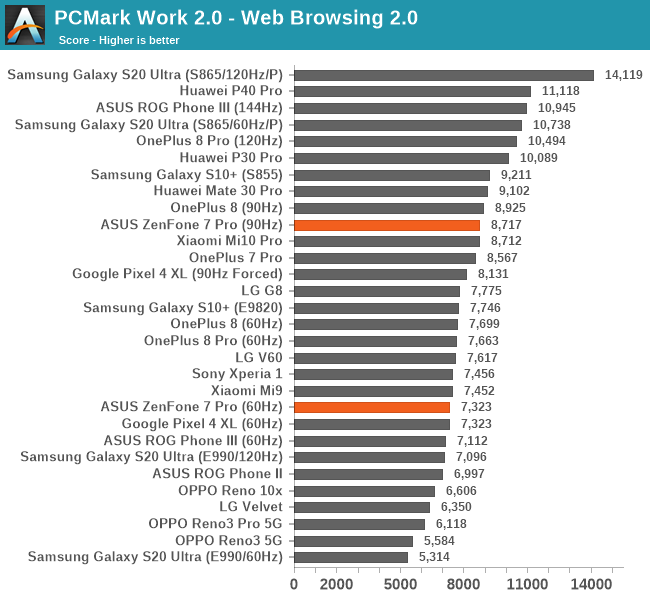
In PCMark’s web-browsing test the scores essentially line up with the refresh rate, and the ZenFone 7 Pro tracks the results of the ROG Phone III at 60Hz, and landing in-between at 90Hz.

In the important writing test, the ZenFone also performed extremely well and represented amongst the better Snapdragon 865 devices.
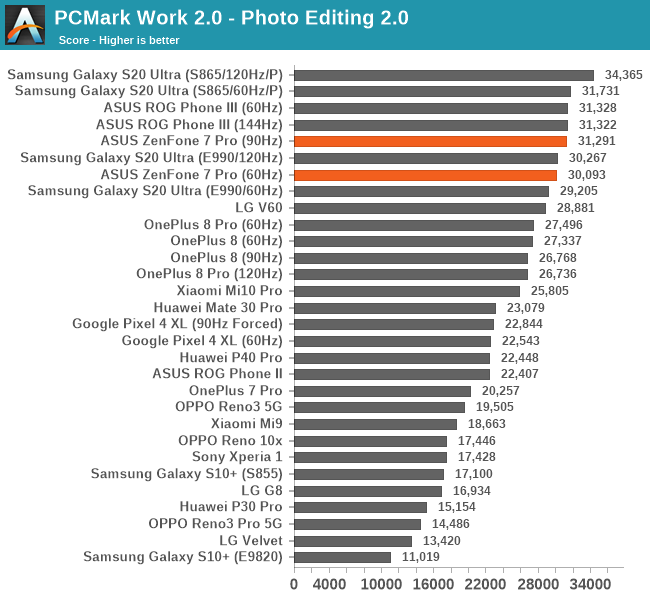
Photo editing is also performing excellently and again slightly ahead of some other S865 phones.
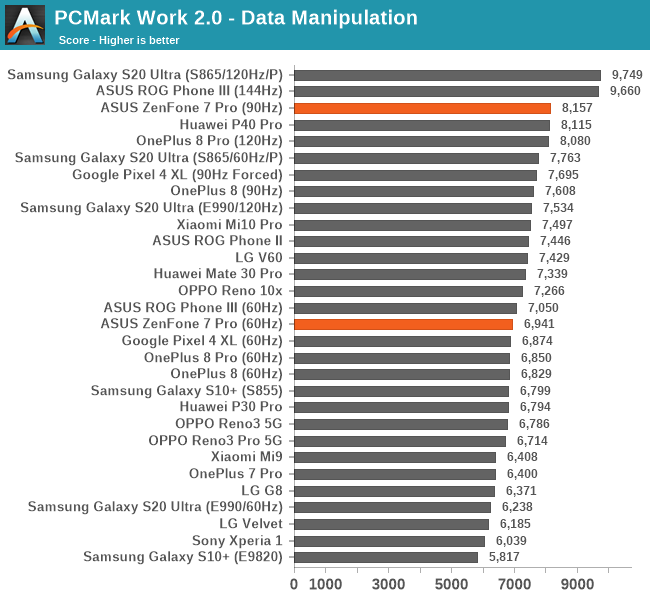
The data-manipulation scaled with the refresh rate bump so it means the ZenFone is able to render frames within the expected 12ms frame-time limit.
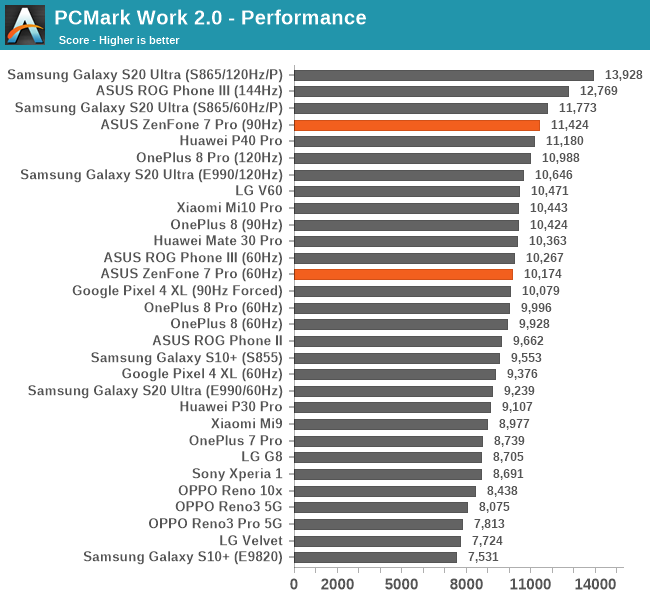
Overall, the ZenFone 7 Pro performed quite well in PCMark and there’s not much we can complain about in regards to its performance.
One thing I need to make note is that I’ve noticed that ASUS is doing some sort of benchmark detection on its phones. On both the ROG Phone III and this new ZenFone 7 Pro I’ve noted that the system detected PCMark. Unlike other detection mechanisms that raise performance in benchmarks, ASUS’s behaviour here seems to have been to force the 60Hz mode, even when 90Hz was enabled in the settings. Using an anonymised version of PCMark bypassed the detection and I was able to get the 90Hz scores and battery life tests. I’ve reached out to ASUS for comment on this, and I’ll update the matter when I hear back a response.
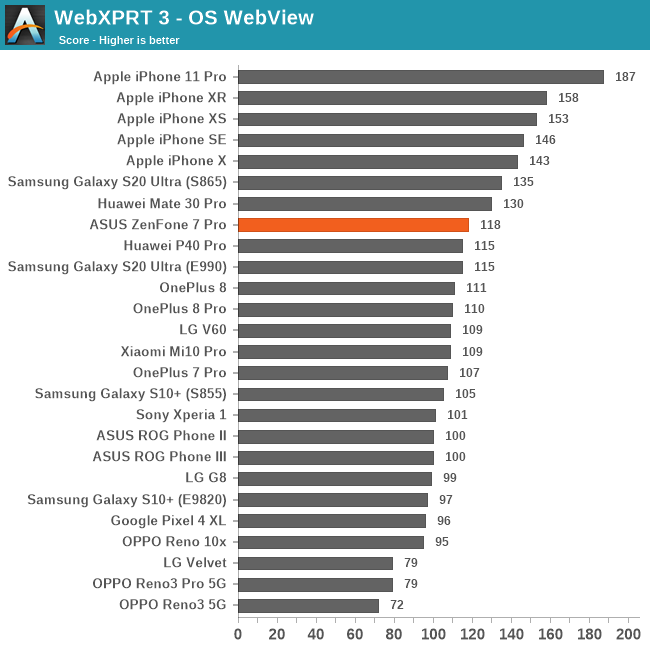
In WebXPRT3 the ZenFone 7 Pro performed significantly better than the ROG Phone III – I’m not sure what’s changed on the OS side of things but it looks like the ZenFone is slightly more aggressively tuned for performance by default.
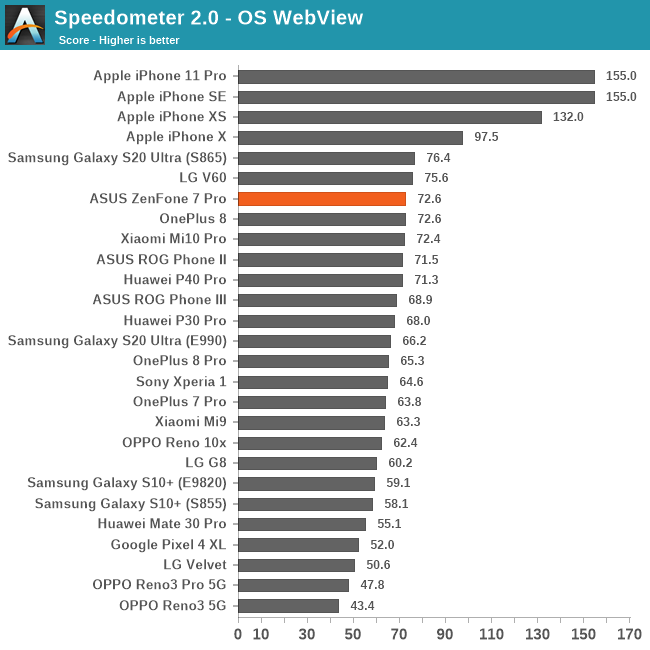
Speedometer 2.0 also doesn’t showcase the same performance oddities as seen on the ROG Phone III and we get top scores here.
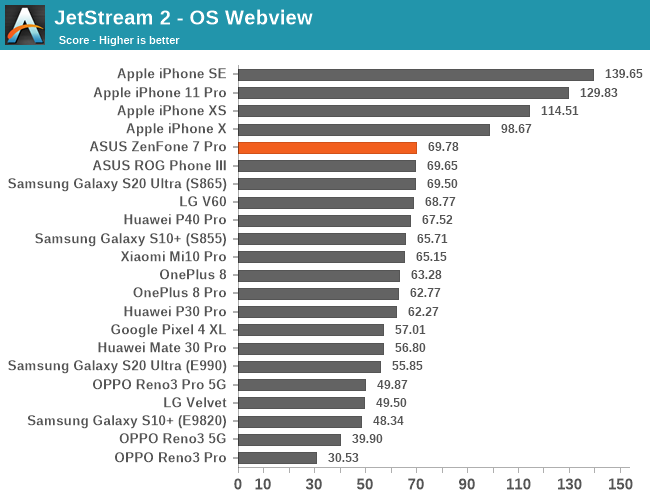
Similarly, JetStream 2 lands where we expect it to.
Overall, performance of the ZenFone 7 Pro is excellent and top-notch amongst current flagship devices. It doesn’t have the 120 or 144Hz refresh rate of some other phones in the market, but 90Hz already marks the biggest jump in user experience, and thanks to the 200Hz touch sampling rate it also gives the feel of an extremely responsive device.
Gaming performance of the ZenFone 7 Pro is also very interesting as it represents a contrasting data-point from the same vendor which also offers a gaming-focused phone such as the ROG Phone III. Both phones also feature the higher performance binned Snapdragon 865+. In the ROG Phone III review we saw somewhat mixed results from the new SoC, so let’s see how the ZenFone fares:

Starting off with Basemark GPU, the ZenFone 7 Pro performs quite excellently in terms of its sustained performance figures, with only a few fps of throttling after prolonged periods.
I’ve noted that the phone’s peak skin temperature reached 44°C, which is still reasonable. In essence, it reaches about the same thermal levels as the ROG Phone III when that phone is set to its “Level 2 X-Mode”.
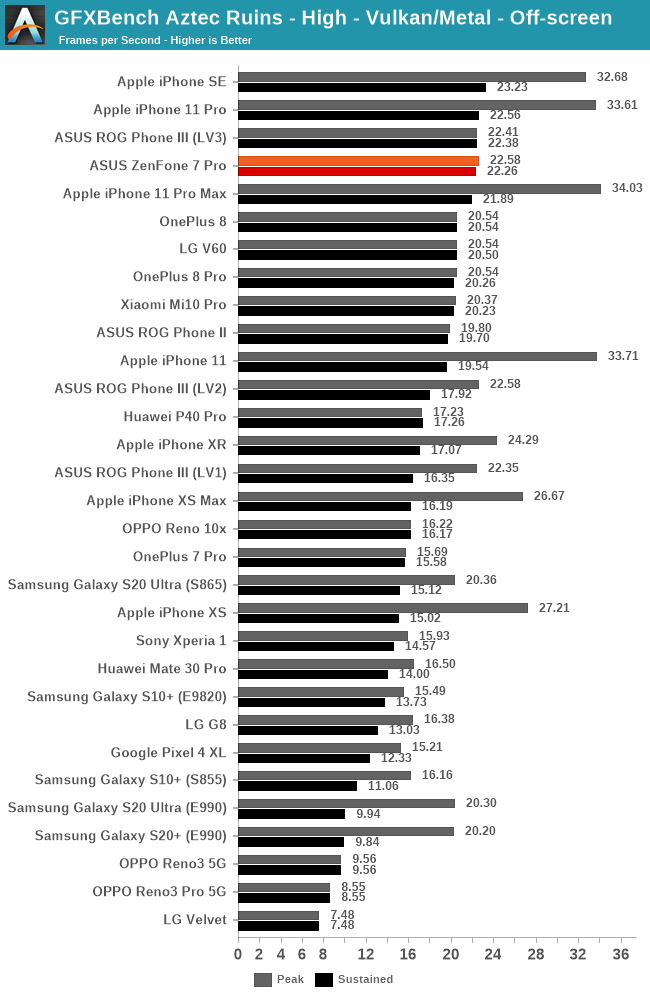
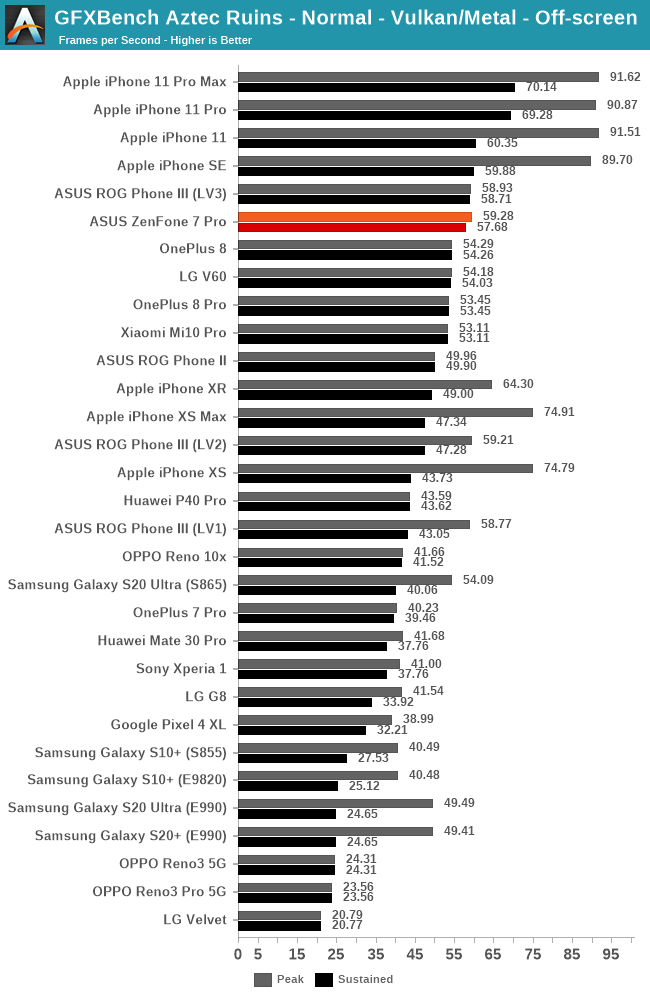
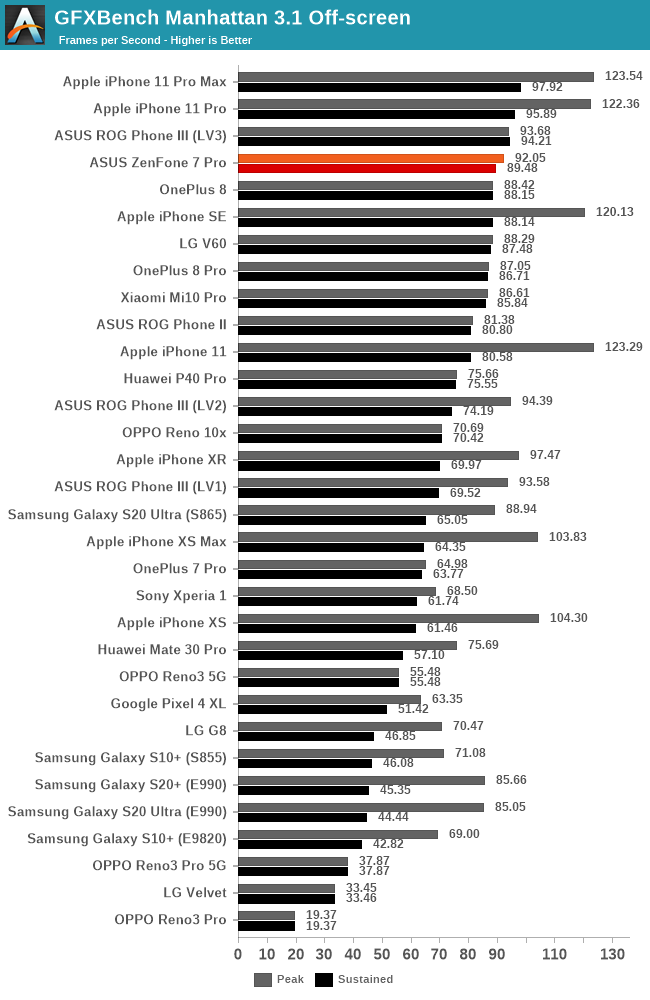
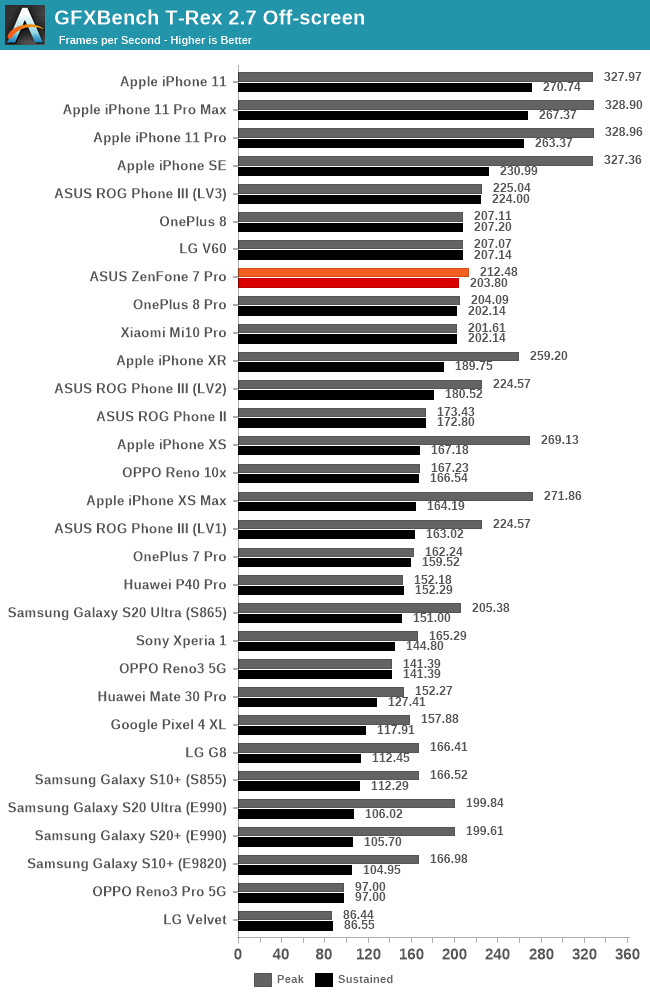
The rest of the GFXBench tests all showcased similar peak and sustained performance figures, strongly favouring the ZenFone 7 Pro.
Frankly speaking this is both a win for ASUS as the ZenFone 7 Pro performs very well, and sort of a self-goal, given that it essentially invalidates performance advantage aspect of the ROG Phone III.
As to why there’s such a stark difference between the two phones, I’m not too sure, however the two devices have quite different motherboard layouts. The ROG Phone III has the SoC placed on a rather narrow motherboard to the side of the phone near the accessory USB-C ports, whilst the ZenFone 7 has it located on a bigger PCB that covers the top part of the phone underneath the cameras. It’s possible that this simple location change allows for better heat dissipation on the ZenFone 7 Pro as the SoC is more centrally located inside the phone, thus making usage of more of the screen as a dissipation area.
The display panel of the ZenFone 7’s is made by Samsung and comes in at a resolution of 2400 x 1080 and a 90Hz refresh rate. There’s nothing too much out of the ordinary for the specs, and represents the middle-ground of what we should expect out of a 2020 smartphone.
Calibration-wise, we see the same display profiles page as on the ROG Phone III, giving us a few different display profiles to choose from. I noted that out of the box the ZenFone 7 was quite blue on its default profile, however switching over to the “Standard” profile will give you the most accurate sRGB colour profile with colour temperature near a 6500K target.
We move on to the display calibration and fundamental display measurements of the ZenFone 7 Pro screen. As always, we thank X-Rite and SpecraCal, as our measurements are performed with an X-Rite i1Pro 2 spectrophotometer, with the exception of black levels which are measured with an i1Display Pro colorimeter. Data is collected and examined using Portrait Display's CalMAN software.
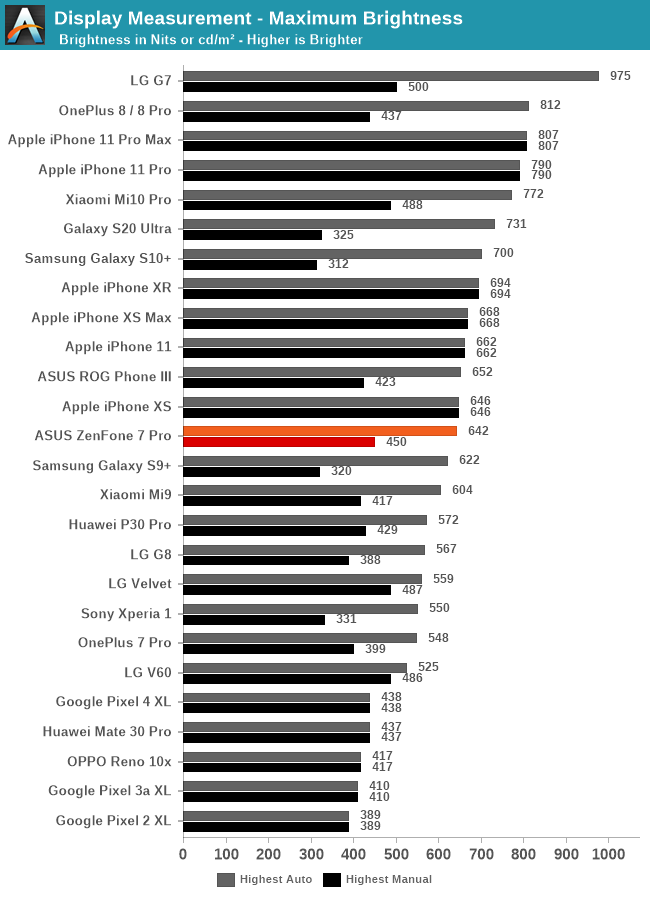
In terms of brightness, the phone reaches 450nits in maximum manual mode, while boosting up to 652nits at full-screen white (100% average picture level). It’s very respectable and gives good legibility in sunlight, albeit a bit behind some of the newer generation displays from the competition.
In the standard profile, colour temperature on my ZenFone 7 Pro sample was a little warm as whites came in at 6340K and average colour temperature over the levels range ended up at 6251K. I actually noted this out of the box, and I preferred to use the colour temperature slider to slightly give cooler tones. We’re still measuring and publishing the default settings for the article though.
In terms of gamma, the ZenFone 7 Pro exhibits the same characteristic as the ROG Phone III in that the device is targeting a 2.4 target rather than the standard 2.2 target for typical web content and the sRGB profile. This results in slightly darker tones in colours.
The saturations accuracy in the sRGB gamut weren’t as good as on the ROG Phone III. Beyond the colour temperature and gamma offset, the ZenFone 7 Pro also showcased some off-hue colours in the magenta range, with some undersaturated reds and blue mid-levels.
The Gretag MacBeth test fared a little better, although unlike the ROG3 where the errors mostly lay in the luminosity of the colour patches, the ZenFone also has a stronger off-target saturations, mostly being undersaturated.
ASUS’s marketing claims of some unspecified deltaE of below 1 however are quite far-fetched as beyond the non-standard gamma you also have quite a bit of off-target colour temperature as well as saturation mishaps. I wish vendors would stop proclaiming specifications which just don’t hold up in practice.
Overall, the display of the ZenFone 7 Pro is pretty adequate and well in line with competing devices at this price range.
The ZenFone 7’s come with a 5000mAh battery which is above-norm compared to other devices on the market. Together with what should be an efficient display and the Snapdragon 865 SoC, we hope the ZenFone 7 Pro to perform quite well in the battery tests.
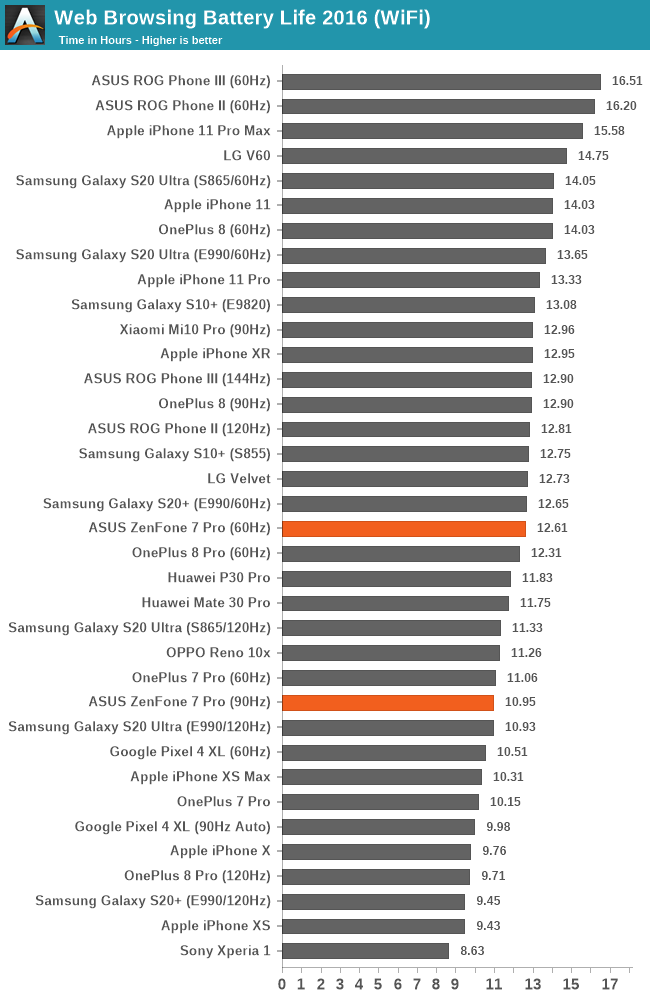
In the web-browsing test, the phone reached “only” 10.95h when in the 90Hz display mode. I say “only”, as given the phone’s very large battery capacity I had expected a little more out of the device. In fact, it lags behind the S20 Ultra which also houses a 5000mAh battery, but runs its screen at 120Hz.
Note: I’m currently rerunning the 60Hz result and will be publishing the figures after the article goes live.

In PCMark, we likewise see some rather disappointing results. At 60Hz, the phone lasted “only” 10.21h which is far below the expectations of a device with such a larger calibre battery. It’s quite a contrast to the ROG Phone III’s 16.33h runtime even though the devices should fare similarly at this refresh-rate, with an only 17% difference in battery capacity.
Likewise, I’m rerunning the 90Hz battery test to verify some results and issues I ran into.
Overall, the ZenFone 7’s battery life was quite odd and behaving quite below expectations. I’m not sure as to why this is happening. It’s true that the ZenFone is tuned to be more aggressive in performance than the ROG Phone III, but the delta in battery life between the two devices is too great, and comparatively to other 1080p 90Hz S865 devices it also doesn’t do as well. The OnePlus 8 with a 4300mAh battery clearly outpaces the ZenFone 7 without too much trouble.
Battery Health & Care
ASUS had put what I deem to be a quite unusual amount of focus on battery health of the device, and I found this to be a breath of fresh air amongst a crowd of vendors who seemingly just want to one-up themselves with absurd high charging speeds.
Beyond allowing for the option to disable fast-charging altogether from the phone side, and having smart scheduled charging features which allow you for example to only top-off the phone to 100% only in the mornings before you wake up, ASUS goes even further and even allows you to artificially limit the maximum state of charge the phone charges to.
Limiting the maximum state of charge level to 80% instead of 100% for example claims to reduce the battery capacity degradation over time by half. The above graph and data showcase the capacity degradation over charge cycles on the ZenFone 6 with 18W fast-charging.
ASUS deemed all these options and features to be beneficial to the customer and his device over prolonged usage – and the battery on the ZenFone 7 is even specially designed with a thicker anode-cathode separator to allow for faster charging and better capacity retention.
ASUS had put what I deem to be a quite unusual amount of focus on battery health of the device, and I found this to be a breath of fresh air amongst a crowd of vendors who seemingly just want to one-up themselves with absurd high charging speeds.
The phone features 30W USB-PD charging and features a corresponding (PPS compatible) charger in the box by default, however they don’t hide that faster charging does degrade your battery faster.
I’ve never seen a vendor be this transparent and forthright about the negatives of fast-charging and battery degradation in general, and I applaud ASUS for it.
The cameras on the ZenFone 7 certainly make for a unique aesthetic feature of the phone, but ASUS has also put some effort into upgrading the camera hardware, and the phone certainly boasts the most advanced setup that the company has put into a smartphone.
The main camera sensor is the same that we saw on the ROG3, which is the Sony IMX686 with 64MP and 0.8µm pixels, 4:1 binning down to 16MP 1.6µm in regular shooting modes. The aperture here is f/1.7 which is actually larger than that of the ROG3 so it looks like we’re dealing with different optics on the ZenFone. Finally, the Pro version we’ve tested today also has OIS.
The ultra-wide module of the phone features a newer generation IMX363 sensor with 1.4µm pixels. This is bigger than the unit on the ROG3 and is really only matched by Samsung’s S20 series for an UWA of this wide field of view at 113°. The aperture also is larger at f/2.2 than the f/2.4 of the ROG3.
Finally, ASUS has employed an 8MP telephoto module with 3x optical magnification. Due to the size constraints of the flip-camera housing the sensor is likely to be quite small both in terms of its physical size and pixels.
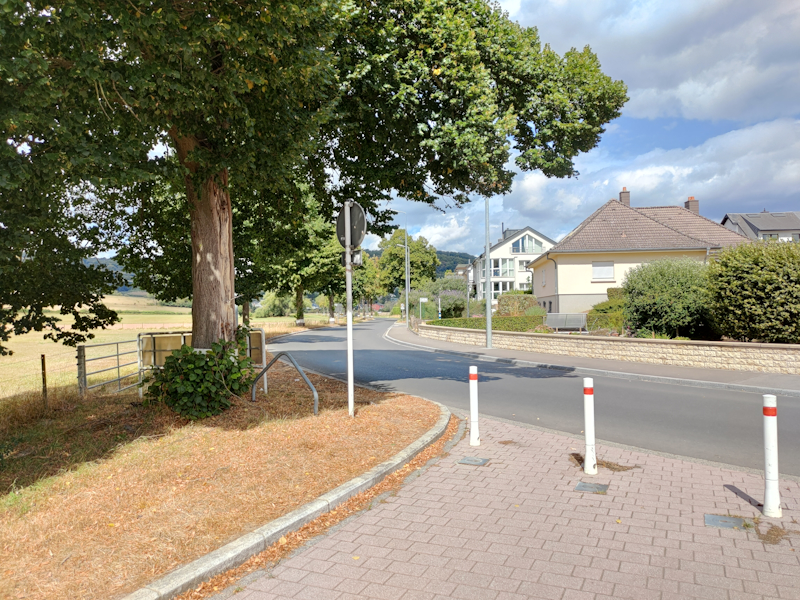
[ Zenfone 7 Pro ] - [ ROG Phone III ]
[ iPhone 11 Pro ] - [ Galaxy S20+(E) ]
[ Pixel 4 ] - [ X-T30 ]
In the first scene, if we’re comparing the ZenFone to the ROG3 at first glance they seem similar, however upon closer inspection we see that the ZenFone has a quite different look to it when it comes to detail. It looks like the ZenFone was able to retain more dynamic range, with highlight textures not quite as flattened out, and with better shadow detail.
Generally, against the competition, the overall exposure is still quite lacking as textures are still lacking contrast, again likely due to the higher exposure and HDR processing.
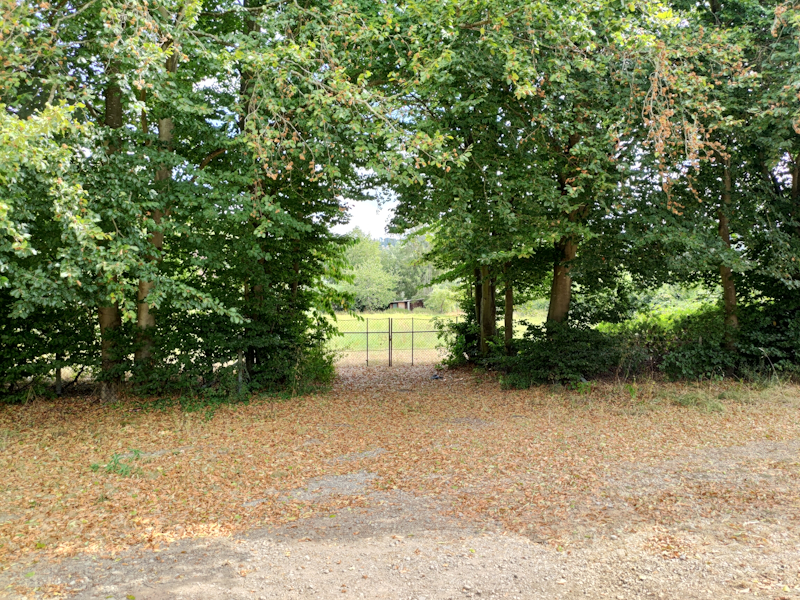
[ Zenfone 7 Pro ] - [ ROG Phone III ]
[ iPhone 11 Pro ] - [ Galaxy S20+(E) ]
[ Pixel 4 ] - [ X-T30 ]
The next shot showcases quite a lot of processing differences with the new ZenFone as it’s able to handle colour temperature more accurately than the ROG3, as well a the HDR also doing a better job.
The most shocking difference however is in the detail-retention as there’s a significant increase in sharpness in the ZenFone. Although both devices look similar in the centre of the image, the outer frame and edges aren’t comparable at all as the ZenFone pulls away from the disaster that was the ROG3’s blurry optics.
Using the 64MP picture mode here might make more sense, but it’s very weird that the phone here in this mode decided for an exposure 4x as slow as the default 16MP mode, and subsequently looks a bit flat.
The telephoto camera detail-wise is very good and provides more than sufficient resolution, producing a very competitive result in that regard. The foreground here is a bit darker than I’d have wished so the dynamic range isn’t quite as strong.

[ Zenfone 7 Pro ] - [ ROG Phone III ]
[ iPhone 11 Pro ] - [ Galaxy S20+(E) ]
[ Pixel 4 ] - [ X-T30 ]
The ultra-wide processing is much better on the ZenFone 7 compared to the ROG3, resulting in a more balanced exposure. The phone still struggles though to retain textures in sunlight as the grass is really lacking contrast when compared to say the S20, with both phones having similar class modules and sensors.
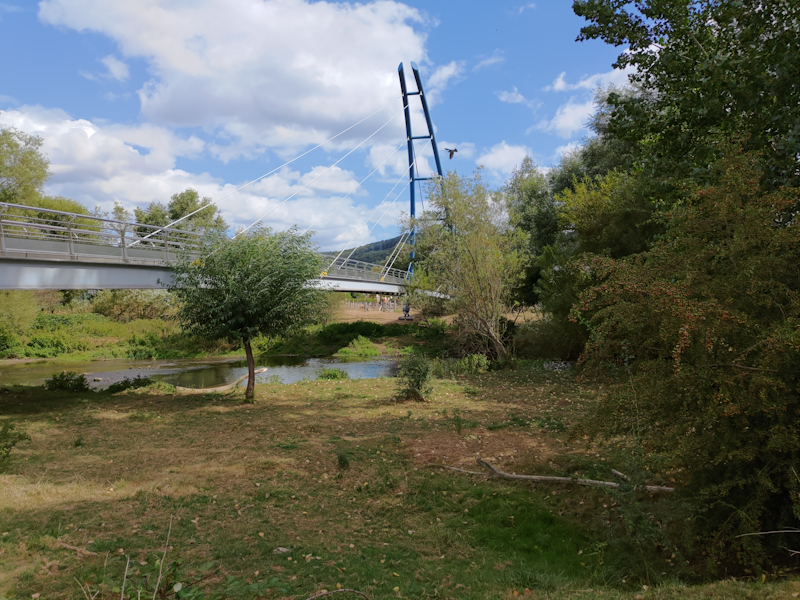
[ Zenfone 7 Pro ] - [ ROG Phone III ]
[ iPhone 11 Pro ] - [ Galaxy S20+(E) ]
[ Pixel 4 ] - [ X-T30 ]
An interesting aspect of devices which employ higher magnification telephoto modules is how they handle intermediary zoom levels which are still relegated to the main camera sensor. In ASUS’ case here on the ZenFone 7 we’re seeing an interesting approach, as the phone is seemingly fusing together pixel data from both the 16MP and 64MP modes. You can see this in the 2x shot in the vegetating which has ghost exposures due to them moving in the wind.
The result is somewhat adequate but can’t compete with real 2x modules, or native high-res modules such as the second wide-module of the S20.

[ Zenfone 7 Pro ] - [ ROG Phone III ]
[ iPhone 11 Pro ] - [ Galaxy S20+(E) ]
[ Pixel 4 ] - [ X-T30 ]
Sometimes when the lighting conditions are kind, the ZenFone is able to produce extremely pleasing images in terms of exposure. This scene was good on all of the phone’s modules and very competitive against all other devices.

[ Zenfone 7 Pro ] - [ ROG Phone III ]
[ iPhone 11 Pro ] - [ Galaxy S20+(E) ]
[ Pixel 4 ] - [ X-T30 ]
Unfortunately, that’s not always the case as ASUS’s processing still has a ton of trouble with exposure and HDR. This shot here was overcast at the moment of capture, but the result still looks way to dark and flat, lacking any kind of highlights in the scene and little dynamic range.
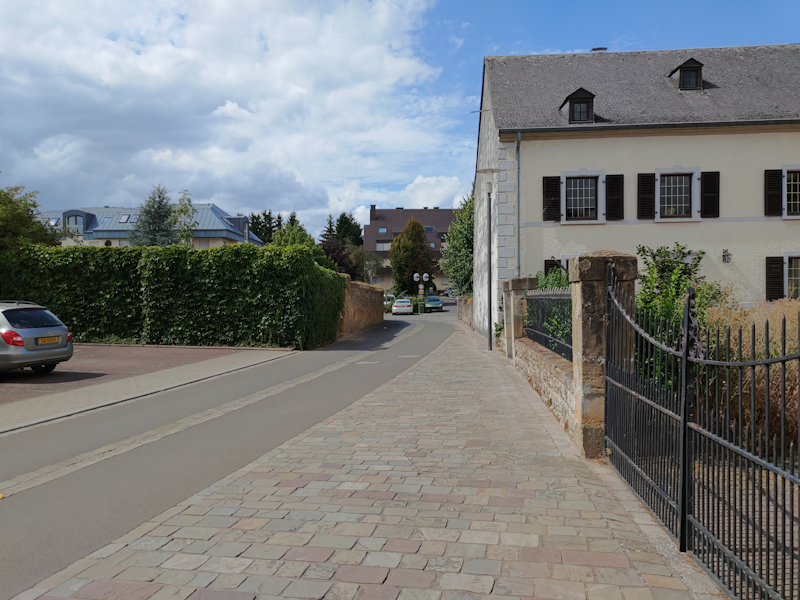
[ Zenfone 7 Pro ] - [ ROG Phone III ]
[ iPhone 11 Pro ] - [ Galaxy S20+(E) ]
[ Pixel 4 ] - [ X-T30 ]
In this scene the processing also fell flat on its face on the main camera, and is actually much worse than what we see on the ROG3. Ironically, the ZenFone’s ultra-wide produces a much better exposure and doesn’t decimate textures into flat colour palettes.
Daylight Capture Conclusion - Solid Foundation, Processing Needs Work
Overall, the ZenFone 7 Pro fared quite a bit better than the ROG Phone III and showcases a more usable camera experience. The optics on the ZenFone are much improved and nowhere near the disaster that was the ROG3.
The new ultra-wide and telephoto modules actually performed quite well in the tests, and both are respectable in their capture abilities.
ASUS’s biggest weakness is processing, and although it seems the ZenFone improves thing a bit, many times it still really falls flat on its face with exposure and HDR, many times producing very flat-looking images that have lost a ton of texture contrast. Because of this, I can’t really say that’s it’s a competitive camera as essentially all other camera vendors will be able to outperform the ZenFone 7.
Low-light capture of the ZenFone 7 is actually an interesting topic as we had seen ASUS’s night mode implementation in the ROG3 perform quite well when it comes to its algorithms for computational photography, albeit being handicapped by the lack of OIS.
The ZenFone 7 Pro does have OIS so we should see quite improved low-light photography results. It’s important to keep in mind though that the results posted here are only representative of the Pro variant, as the standard base model doesn’t feature OIS, with results likely much worse than what’s presented here.

[ Zenfone 7 Pro ] - [ ROG Phone III ]
[iPhone 11 Pro ] - [Galaxy S20+(E) ]
[ Pixel 4 ] - [ X-T30 ]
The first scene is actually quite impressive as the ZenFone is able to achieve a quite excellent results that is very competitive and easily beats the shots of the iPhone 11 and the S20’s. The OIS allows the phone for a longer exposure compared to the ROG3 and to fill in more of the shadows of the scene.
The ultra-wide also benefits from night-mode and the newer sensor, however the result remains quite blurry compared to what the S20 is able to achieve.
The telephoto module in low-light isn’t very good – in this instance it didn’t even manage to focus on the subject.
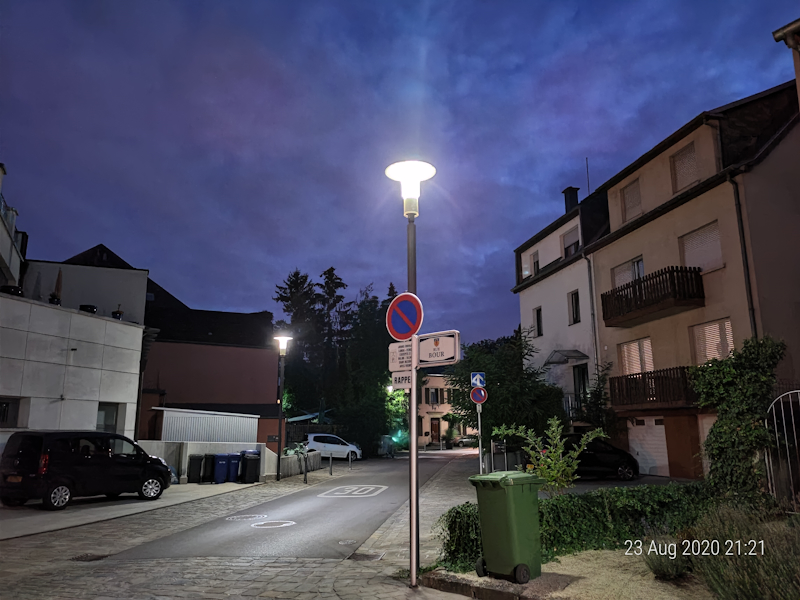
[ Zenfone 7 Pro ] - [ ROG Phone III ]
[ iPhone 11 Pro ] - [ Galaxy S20+(E) ]
[ Pixel 4 ] - [ X-T30 ]
The next shot also is very much in favour of the ZenFone 7 Pro as it’s extremely comparable to the Pixel 4 picture and amongst the best results in the set.
The ultra-wide here unfortunately didn’t do well as it’s completely blurry.
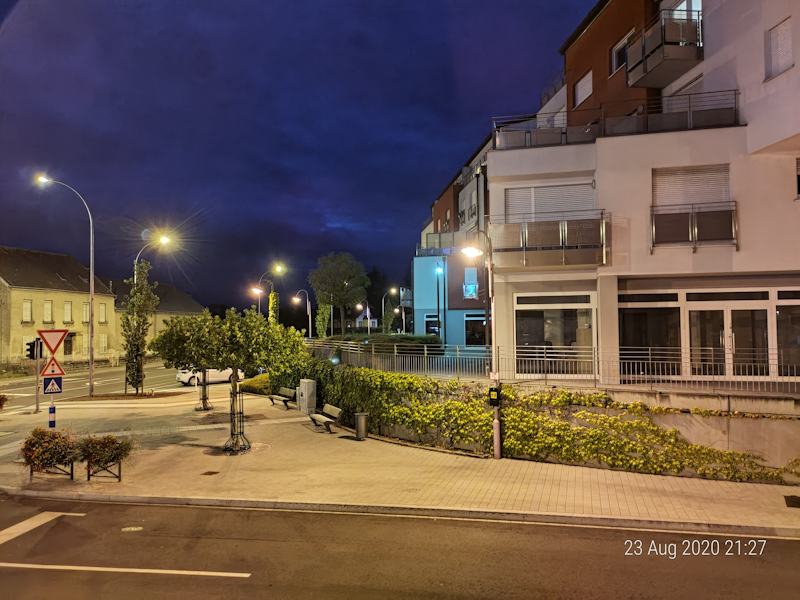
[ Zenfone 7 Pro ] - [ ROG Phone III ]
[ iPhone 11 Pro ] - [ Galaxy S20+(E) ]
[ Pixel 4 ] - [ X-T30 ]
When there’s a bit more light, the ZenFone also fares extremely well and it’s again quite surprising to see just how similar the ASUS device compared to the Pixel 4. The ZenFone actually wins out in details, however both phone’s colour temperatures are wrong as the iPhone is closest to the actual colour of the sodium lamps on the street.
The telephoto module here is somewhat usable albeit it’s very noisy. Night mode doesn’t work on this module.

[ Zenfone 7 Pro ] - [ ROG Phone III ]
[ iPhone 11 Pro ] - [ Galaxy S20+(E) ]
[ Pixel 4 ] - [ X-T30 ]
The ROG3 already had done quite well in this scene before, and the ZenFone 7 Pro produces even sharper image with extremely good handling of the highlights and overall processing. I would even go as to say that it’s the best performing device amongst the comparison phones.

[ Zenfone 7 Pro ] - [ ROG Phone III ]
[ iPhone 11 Pro ] - [ Galaxy S20+(E) ]
[ Pixel 4 ] - [ X-T30 ]
Again, it’s the OIS which makes the difference to the ROG3 as in lower light conditions the ZenFone 7 Pro manages a 2.6x higher exposure through a combination of slower shutter speeds as well as a higher ISO level.
I would again as to say it’s amongst the best performers here as it manages to still retain a lot of detail, and most importantly it also got the colour temperature right.
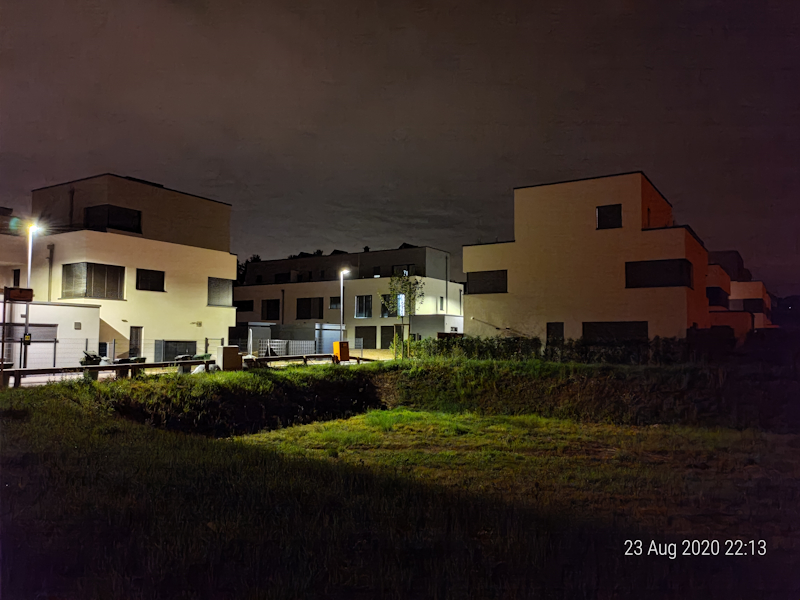
[ Zenfone 7 Pro ] - [ ROG Phone III ]
[ iPhone 11 Pro ] - [ Galaxy S20+(E) ]
[ Pixel 4 ] - [ X-T30 ]
Further in extreme low-light, the ZenFone 7 Pro continues to impress with its superior night mode, able to retain a ton of detail and more dynamic range than other phones.
Low-Light Conclusion - A Surprise Top Contender
Overall, the ZenFone 7 Pro really surprised me in terms of its low-light capture ability. ASUS’s Night Mode showed potential on the ROG3, and the addition of OIS really augments the whole camera system to a level that’s not only competitive with other smartphones on the market, but more often than not it actually beats them when it comes to detail and exposures.
The ultra-wide isn’t as well tuned as the main camera, and here it mostly loses out to Samsung’s night mode implementation. The telephoto module is largely not usable in low-light.
Video recording on the ZenFone 7 Pro should be relatively well performing given it has the combination of OIS as well as a quite excellently performing EIS implementation which we’ve already seen on the ROG3. What remain to be seen is how video recording works with the new telephoto module as well as the new ultra-wide sensor.
Starting off with the main camera at 4K30, things actually aren’t looking too great for the ZenFone. The video show massive EIS jitter that’s massively distracting and looks quite bad with flashing details throughout the scene. We’re also seeing a fair bit of exposure fluctuations.
ASUS doesn’t expose the telephoto module to video recording at all in 4K resolution as the 8MP sensor simply isn’t sufficient for it, so you’d have to revert down to FHD to use it.
60fps recording doesn’t help much in terms of providing a stable image as the OIS and EIS are still fighting each other. What’s new here is that updated ultra-wide sensor now also enables 4K60 video recording.
Finally, 8K video is quite disappointing as there’s a big image crop, and there’s just worse dynamic range, beyond the impracticality of 800MB per minute recording. The positive here at least is that the ZenFone 7 has a microSD card slot.
It was a slightly windy day when I was recording these samples and unfortunately it looks like the microphone is quite prone in picking up wind noise.
Overall, video recording on the ZenFone 7 was quite disappointing due to the seemingly struggling EIS, and video quality suffers a lot.
As we wrap up the review of the ZenFone 7 Pro, we’ve come to make some noteworthy points about ASUS’ new flagship device, most of them positive, but also with some negatives.
Starting off with the design of the phone, the one thing that’s notable about the ZenFone 7 versus the previous generation ZenFone iterations is simply that this year’s model is supersized to a larger form-factor, which might not be to everyone’s taste. Although short of being a beast like the ROG Phone III, at 77.28mm wide and 230g heavy, the ZenFone 7 will dwarf many other phones in the market.
Thankfully due to the rounded back glass panel and frame, the phone still manages to have good ergonomics and doesn’t feel quite as big as it is.
The display on the ZenFone 7 is meant to be a key feature for the phone, but that’s not due to its specs as the 1080p 90Hz panel doesn’t really stand out in any regard, being mostly average across the board. Instead, the lack of a display notch or hole camera cut-out is the phone’s special feature, enabled through the unique flip-camera design. ASUS’s hardware implementation is generally excellent and the whole mechanism feels extremely solid. The positive of such a system is that you’re getting extremely high-quality selfie cameras as you’re essentially using the main cameras of the phone.
Performance of the ZenFone 7 Pro was excellent and in most cases top-notch. In fact, gaming performance was so good that it puts into question why you’d buy the ROG Phone III.
One answer to that question would be battery life. Oddly enough, the ZenFone 7 Pro didn’t fare quite as well in this regard, and actually landed well short of expectations, barely matching other 120Hz devices of the same class. I’m not sure why this is, and we’re still rerunning battery tests right now, but it just seems the phone isn’t as efficient as competitor devices or the ROG Phone III. It’s not a bad performance thanks to the 5000mAh battery, but it’s also not what you expect when you consider its capacity.
ASUS’s camera performance on the ROG Phone III wasn’t too great, and I’m glad to report that the ZenFone 7 does improve upon it by quite a bit. The new sensor has stronger optics, the telephoto module is generally quite competitive, and the new sensor on the ultra-wide has also augmented the picture quality of this module. Nevertheless, ASUS still has a long way to go in terms of software processing, as daylight shots often still have large issues with exposures and HDR processing, making the ZenFone 7 still rather lacklustre here.
Low-light photography was a big surprise, as ASUS’ night mode computational photography mode is seemingly top-notch, not only competing with the best of the best, but many times actually being the top performer in our testing. It’s to be noted that this praise can only be said of the Pro variant, as the regular model’s lack of OIS is likely to make it lag behind by quite a bit.
One big surprise for me was the overall software experience as ASUS’ latest ZenUI software interface seemed quite well designed and keepings things clean and functional, all whilst adding a lot of useful features.
Discussions about availability and pricing of the ZenFone 7 series are quite complicated to make due to the phone currently only being officially announced in Taiwan. There, the phone comes in at TWD 21999 and 27990 for the regular and Pro models, which comes to around USD 750 and 950.
For the Pro model, what I think is missing from the package is a better daylight camera experience. Without that, I don’t think the phone is competitive in its pricing as you can get much better value alternatives such as the OnePlus 8 Pro or the S20+.
The regular variant seems more reasonable in its price, but then again there’s the camera aspect which comes at play, and a OnePlus 8 would again present the better value device.
It’s kind of hard to position the ZenFone 7 and 7 Pro in the market – if they were perfectly performing devices, then those prices could be rationalised, however as a matter of fact, there’s some lacklustre aspects to them. ASUS has to either really up their camera processing game in the coming months with firmware updates, or quickly reduce the pricing to something that’s closer to the $560 mark at which the ZenFone 6 was released last year.
"triple" - Google News
September 01, 2020 at 03:00PM
https://ift.tt/3jAP4pA
The ASUS ZenFone 7 Pro Review: The Triple Flip-Camera - AnandTech
"triple" - Google News
https://ift.tt/3dc0blF
https://ift.tt/2WoIFUS
Bagikan Berita Ini
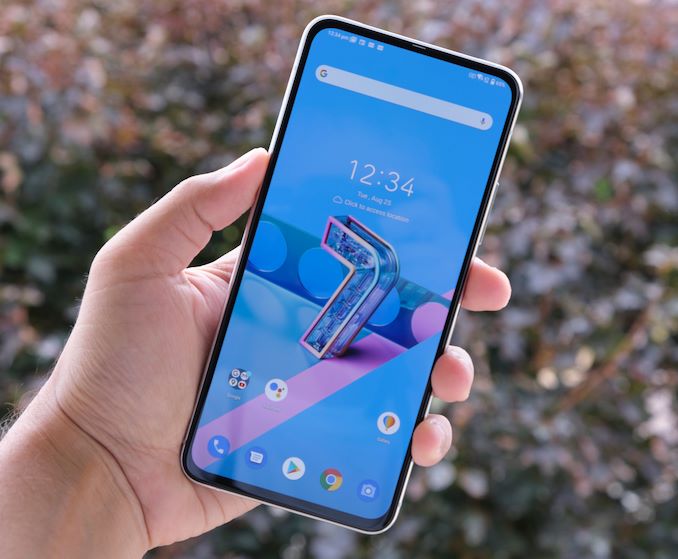

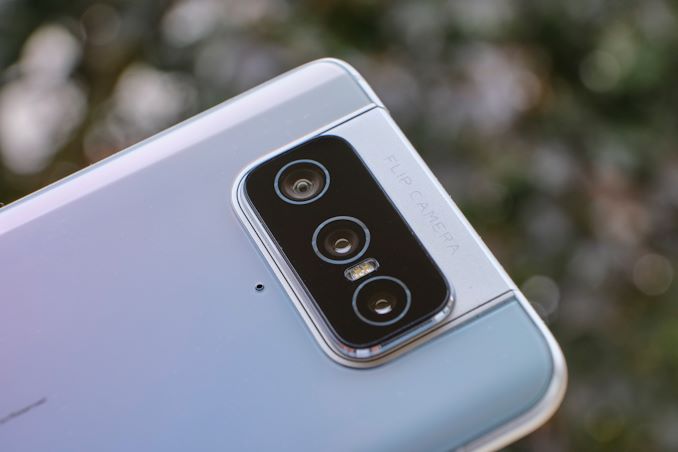
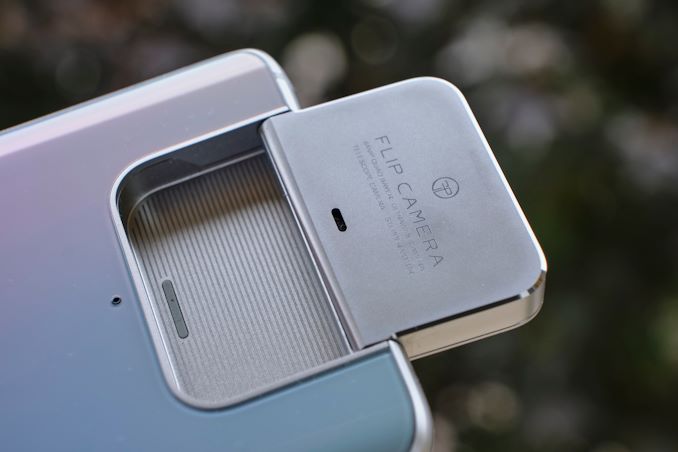

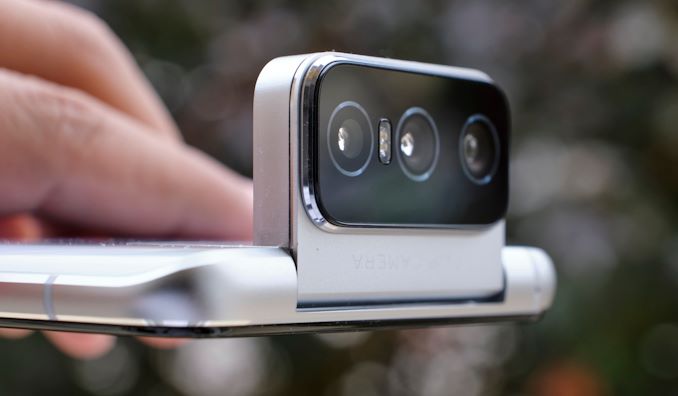



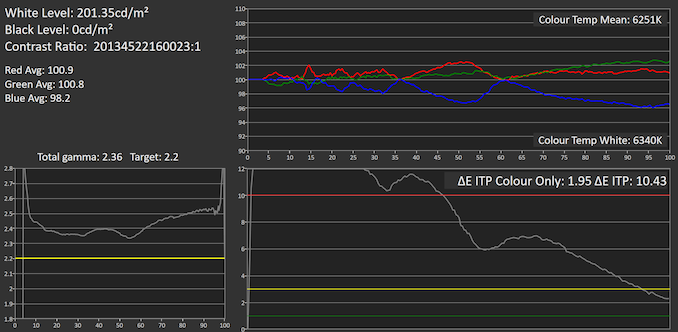

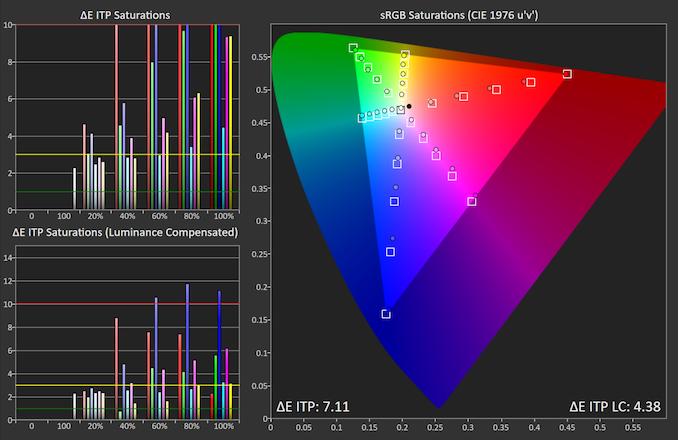
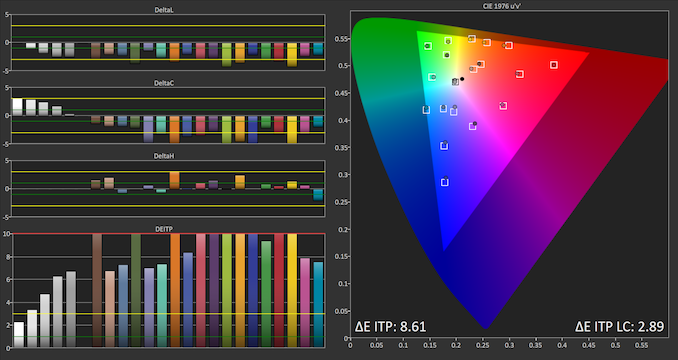


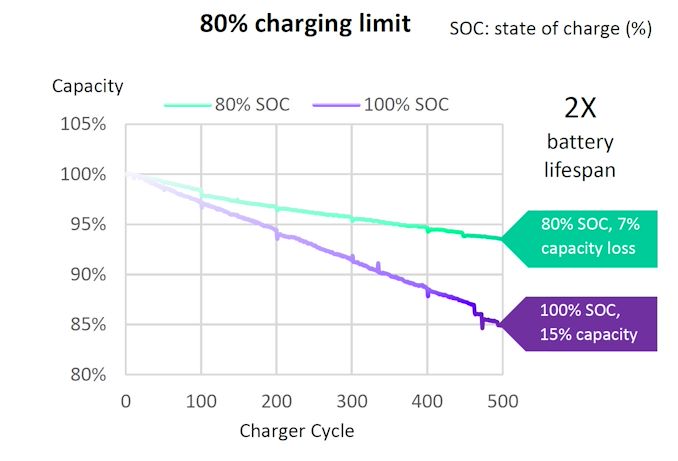
















0 Response to "The ASUS ZenFone 7 Pro Review: The Triple Flip-Camera - AnandTech"
Post a Comment